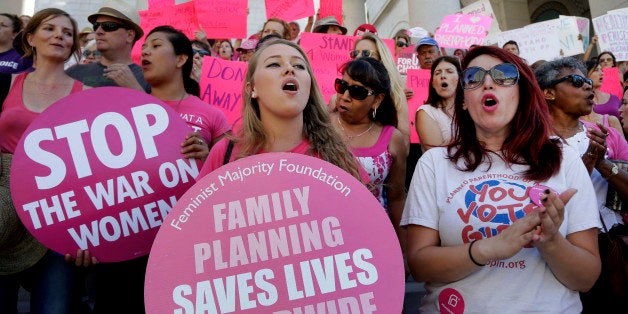
Lately, politicians and policy makers have been continuously discussing the importance of the women's economic agenda. This is a good thing because even though women earn most of the college and advanced degrees in this country, and are two thirds of their family's breadwinners, forty-two million women, and the 28 million children who depend on them, are living paycheck to paycheck, one disaster away from economic ruin. Paid sick days, paid parental leave, and raising the minimum wage are among some of the important policy changes being discussed, but not access to reproductive health care, a crucial component to women's economic success in the U.S.
Today is the 39th anniversary of the Hyde Amendment. Every year since 1976, Congress has passed the Hyde Amendment, which prohibits federal coverage of abortion for women enrolled in Medicaid. Over 60 percent of women who obtain abortions have incomes below 200 percent of the federal poverty line, meaning many of those 42 million women living paycheck to paycheck.
What's even more striking is data from the Turnaway Study, a landmark longitudinal study conducted by Advancing New Standards in Reproductive Health (ANSIRH) at the University of California at San Francisco (UCSF). The study tracked across 30 abortion facilities in 21 states what happens to women who seek but are "turned away" from the abortion care they need. Its findings, summarized in a report by the Reproductive Health Technologies Project, showed that of the women in the Turnaway study who made it to the clinic, 60 percent lived below 100 percent of the federal poverty line. And almost half of the women were qualified and enrolled in public safety net programs.
While women of all economic and racial backgrounds have abortions, those most affected by lack of access to reproductive health care are women living on the economic brink and are more likely to be women of color. African American, Hispanic, and Native American women all have poverty rates that hover around 25 percent compared to a 10.3 percent poverty rate for white, non-Hispanic women. According to the Guttmacher Institute, African American women are more than three times more likely to have a higher unintended pregnancy than their white counterparts. Latina women are two times more likely. Due to these higher unintended pregnancy rates, women of color seek abortions at a higher rate than white women.
Why are the unintended pregnancy rates higher for women of color? The challenges of living in poverty make it hard to access high-quality contraceptive services or to pick a chosen method of birth control to be used consistently and effectively over long periods of time. Issues of access include: geographic distance from clinics, money, life events, relationships changes, personal crises, and cultural or linguistic barriers, all which are common for all women but can become magnified significantly and directly impact method continuation and usage when you are a low income woman already very busy, stressed, and living paycheck to paycheck with children (since 60 percent of women who have an abortion already have children).
It is no surprise then the first known victim of the Hyde Amendment was a woman of color named Rosie Jimenez. In 1976, Rosie was a 27-year-old Latina woman in college who was also a single mother. She was close to getting her degree when she discovered she was pregnant. She went to a doctor in her hometown, and as a Medicaid recipient, she could not get the abortion she needed because the doctor would not be reimbursed for the service, and she could not afford it out of pocket. She thought about using her scholarship money, but she didn't want to delay getting her degree and a path to a new life for her and her daughter, so obtained a cheaper, but illegal and unsafe abortion. She died seven days later in a hospital from septic shock.
If you are a lower income woman who is qualified and enrolled in public insurance, coverage bans like the Hyde Amendment make access to abortion nearly impossible. The Turnaway Study found that almost half of the women received support from public safety net programs. And over two-thirds of the women who obtained an abortion received some form of "financial assistance" from Medicaid or charitable organizations. It's not reproductive rights when you can't access your right to reproductive health care.
Some anti-choice politicians and activists say "if you don't want to get pregnant, practice abstinence." Well, yes that's an option and many do that. But let's be absolutely clear, it is a personal choice as to how women and men conduct their personal sex lives. The job of policymakers and advocates should be to ensure all legal and safe options are available for those women to make their own personal decisions. That means protecting funding for Planned Parenthood that provides access to contraception, counseling and care for sexually transmitted infections, and yes, abortion. That means supporting the American Affordable Care Act which provides birth control without cost sharing, and yes that means lifting all federal insurance coverage bans on abortion.
Politicians want to talk about the women's economic security agenda. Indeed, economic security policies cannot be legitimate without understanding the need not only for paid sick days, raising the minimum wage, and parental leave, but also the right of all women, regardless of their income, to access the full range of reproductive health care, including abortion.
